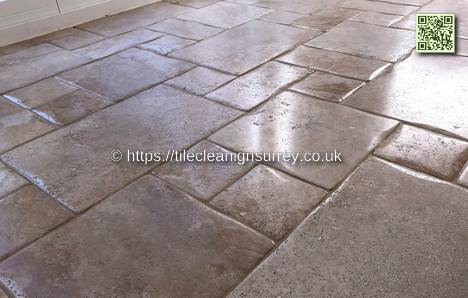s TravertineTravertine is a highly sought-after natural stone for indoor and outdoor applications. Its unique texture, earthy tones, and cultural significance have made it popular among designers, developers, and homeowners. This guide will explore the benefits of travertine, the different types available, its uses, and essential maintenance tips, helping you make informed decisions for your next building or remodelling project.
The Formation and Characteristics of Travertine
Travertine, a type of limestone, forms in hot mineral springs through the precipitation of calcium carbonate. This process creates the stone's distinctive porous texture and unique vein patterns. Travertine is commonly found in regions with significant geothermal activity, including the United States, Turkey, and Italy.
The mineral composition of travertine, mainly calcite and aragonite, gives it both durability and a unique appearance. Its porous structure allows for various finishes—polished, honed, or tumbled—making it a versatile option for different architectural styles.
Explore the Different Types of Travertine for Your Projects

Travertine offers a variety of types, each with its own aesthetic and functional advantages, allowing for endless design possibilities that spark creativity.
Classic Travertine: Timeless Elegance
Classic travertine, characterized by its light, neutral tones and subtle vein-cut patterns, adds a timeless elegance to contemporary and traditional designs, infusing spaces with enduring beauty and sophistication.
Noce Travertine: Warm and Inviting
Noce travertine's rich, earthy brown hues create a warm and welcoming atmosphere in indoor and outdoor spaces, offering comfort and a sense of homeliness in your design choices.
Silver Travertine: Modern Sophistication
Silver travertine blends grey, silver, and white tones and is perfect for modern, minimalist designs seeking a sleek and sophisticated look. Its unique colour variations can produce striking visual effects.
Walnut Travertine: Earthy Elegance
Walnut travertine combines the warmth of Noce with the neutrality of Classic travertine. Its medium brown tones, accented with hints of gold, make it an excellent choice for creating an elegant yet earthy ambience.
Ivory Travertine: Subtle Versatility
Ivory travertine, with its cream-coloured tones, pairs effortlessly with various other colours, making it ideal for creating a clean, bright look in kitchens, bathrooms, and other spaces.
The Many Applications of Travertine in Construction
Travertine’s natural beauty and durability make it an excellent choice for enhancing various areas of your home or commercial space. Let’s explore how this versatile stone can elevate different applications.
Transform Your Floors with Travertine
Travertine flooring is a popular choice thanks to its natural, non-slip surface. This makes it ideal for high-traffic areas like kitchens, bathrooms, and hallways. This stone’s exceptional durability ensures it can withstand everyday use while maintaining its stunning appearance for years.
When selecting travertine flooring, consider the finish that best suits your style and needs. Honed and tumbled travertine offers a rustic, matte look, perfect for a more casual, earthy feel. For a more refined, luxurious touch, polished travertine provides a sleek, reflective surface that adds elegance to any space.
Elevate Your Outdoor Spaces with Travertine Pavers
Travertine pavers are a favourite for outdoor areas such as patios, pool decks, and garden paths. The stone’s natural porosity keeps it cool underfoot, even in direct sunlight, providing comfort for barefoot walking. Moreover, travertine’s resistance to weathering ensures it remains beautiful over time, regardless of the elements.
Tumbled travertine pavers are top-rated for outdoor use. Their texture enhances visual appeal and improves grip, making them safer to walk on, even when wet.
Add a Luxurious Touch with Travertine Countertops
Travertine countertops bring a touch of luxury to kitchens and bathrooms. Their unique patterns and warm tones create a sophisticated, timeless look. With proper sealing, travertine countertops offer durability and resistance to heat, making them both a practical and elegant choice for your space.
Travertine countertops bring a touch of old-world charm to kitchens and bathrooms. Though softer than granite or tile, travertine’s unique veining and warm tones make it a popular choice for those seeking to incorporate natural beauty into their interiors.
Sealing travertine countertops regularly is important to preserve their appearance. This protective layer helps prevent damage and keeps the stone looking its best.
Transform Your Space with Travertine Wall Cladding
Travertine wall cladding adds depth and texture to both interior and exterior walls. Whether it’s a feature wall in a living room or the façade of a building, travertine transforms any surface into a striking visual statement. Vein-cut travertine is incredibly impactful, with its linear patterns creating a dynamic sense of movement.
Unleash Creativity with Travertine Mosaics
Travertine mosaics offer endless opportunities for creative design. These beautiful stone pieces can be arranged in various patterns to create stunning backsplashes, shower surrounds, or decorative accents. The natural variations in colour and texture make each mosaic installation a unique and vibrant work of art.
Best Practices for Maintaining and Caring for Travertine
Maintaining the beauty of travertine requires regular care. Follow these simple practices to keep your travertine surfaces in top condition.
Clean Regularly with pH-neutral Solutions.
Travertine is sensitive to acids, so always use a pH-neutral cleaner for regular cleaning. Avoid vinegar, lemon juice, and other acidic products, as they can damage the surface and dull the shine. Opt for stone-specific cleaners that remove dirt and grime without harming the stone.
Seal to Protect Against Stains
Sealing your travertine is crucial, especially in high-traffic areas or places exposed to moisture. A quality stone sealer creates a protective barrier that prevents stains from penetrating the stone’s porous surface. Depending on usage, reseal your surfaces every 6 to 12 months to maintain their protection.
Act Quickly on Spills and Stains
To minimize staining and etching, clean spills immediately. Blot the spill with an absorbent cloth or paper towel rather than wiping, which can spread the liquid and cause more damage. For stubborn stains, a poultice made of baking soda and water can effectively lift the stain without harming the stone.
Protect High-Traffic Areas with Rugs and Mats
Use rugs or mats in high-traffic areas to prevent scratches and wear on travertine floors. Place mats at entryways to catch dirt and debris before they reach the stone surface, and use felt pads under furniture to avoid scratches.
Avoid Harsh Cleaning Tools
When cleaning travertine, avoid harsh tools like steel wool, green scrubbing pads, or stiff brushes, as they can scratch the stone. Instead, use soft cloths and microfiber mops to clean and maintain your travertine surfaces gently.
Choosing Travertine Responsibly: A Sustainable Approach
While quarrying and processing travertine have environmental impacts, responsible sourcing and mindful use can make it a sustainable choice for building and design.
Ethical Sourcing for a Greener Future
When selecting travertine, prioritize suppliers committed to ethical sourcing. This includes minimizing environmental damage during quarrying and ensuring fair treatment and wages for workers. By choosing ethically sourced travertine, you support sustainable practices within the natural stone industry.
Recycling and Reusing Travertine
Travertine’s durability makes it ideal for recycling and reuse. Old travertine tiles, pavers, and cladding can be repurposed in new projects, reducing the demand for new materials and minimizing waste. Furthermore, travertine’s natural composition makes it fully recyclable at the end of its life cycle.
Lowering the Carbon Footprint of Travertine
Opting for locally sourced travertine reduces its carbon footprint by reducing transportation-related emissions. Additionally, using lighter-coloured travertine can lower energy consumption in buildings by reflecting more sunlight and decreasing the need for artificial cooling.
FAQs about Travertine
Marble v: What’s the Difference?
Travertine is a type of limestone, while marble is limestone that has transformed under high pressure and temperature. It is more porous with a textured surface, whereas marble is denser and offers a smoother, polished finish.
How to Prevent Etching on Travertine
Etching occurs when acidic substances dull the surface of the travertine. Avoid acidic cleaners and immediately clean up spills like wine, citrus juice, or vinegar to prevent this. Regular sealing also provides additional protection against etching.
Is Travertine Suitable for Cold Climates?
Yes, travertine can be used in cold climates if you select a thick, high-quality variety that can endure freeze-thaw cycles. Proper installation, including using sealers and ensuring good drainage, is essential to prevent damage.
Modern Design with Travertine: Is It Possible?
Absolutely. Travertine’s versatility makes it ideal for modern designs. Silver and grey travertine varieties are prevalent in contemporary architecture, providing a sleek and sophisticated look for floors, walls, and countertops.
Why Choose Travertine for Pool Decking?
Travertine is an excellent choice for pool decking due to its natural slip resistance, ability to stay cool underfoot, and durability against weathering. Thus, it is both a practical and attractive option for outdoor spaces.
The post The Ultimate Introduction To Travertine: Benefits, Types, and Maintenance sponsored by Travertine Cleaning Cobham
The Article The Essential Guide to Travertine: Benefits, Varieties, and Care Tips appeared first on https://fabritec.org
The Article The Essential Guide to Travertine: Benefits, Varieties, and Care Tips Was Found On https://limitsofstrategy.com
The Article The Essential Guide to Travertine: Benefits, Varieties, and Care Tips First Appeared ON
: https://ad4sc.com


I’ve always been fascinated by how natural stone like travertine tells a story through its formation. The way it’s created in hot springs seems so magical and definitely adds a layer of charm to any space. I remember visiting some stunning historical sites in Italy where travertine was used, and it really made the architecture pop with character.
Your exploration of travertine truly highlights the fascinating intersection of nature and design. I’ve always been drawn to materials that tell a story, and travertine certainly fits that bill. The fact that it forms in hot mineral springs not only connects it to the Earth’s geological processes but also infuses it with a sense of history and culture, particularly with its rich associations in places like Italy and Turkey.
Your perspective on travertine really resonates with me. There’s something special about the stories that materials can tell—especially when they’re tied to specific locations and histories. I remember visiting the ruins of ancient Rome, where travertine is so prominently featured. It’s fascinating to think about how this stone has withstood the test of time, witnessing not just architectural feats but the ebb and flow of civilizations.
I really appreciate your thoughts on travertine and how it serves as a window into history. It’s intriguing to think about the journey of a material over centuries, particularly one that has been so crucial in iconic structures like the Colosseum and St. Peter’s Basilica. When I visited Rome, I was struck not just by the beauty of the travertine, but by the way it reflects the culture and values of the time it was quarried.
It’s fascinating how materials like travertine can carry so much history and meaning within them. When I visited the Colosseum, I found myself imagining the sheer scale of human endeavor and ambition involved in its construction, especially using such a beautiful stone. It really does capture the essence of the culture that surrounded it—the artistry, the engineering prowess, and even the social dynamics of the time.
I completely resonate with your appreciation for materials like travertine that carry such depth and history. There’s something so special about using a natural stone that has been shaped over millennia, especially in the context of architecture and design. It’s intriguing how travertine transcends mere aesthetics and actually embodies the essence of the locations it comes from, infusing spaces with a story of their own.
You’ve hit the nail on the head with that perspective, and I love where you’re coming from on this. There’s a certain romance to materials like travertine that can’t be ignored, right? I mean, how often do we get to have a product in our homes that’s had a front-row seat to thousands of years of Earth’s drama? You can almost imagine the stories it could tell—if only it could speak.
I really appreciate your thoughts on travertine and its ability to weave together nature’s artistry and human creativity. It’s fascinating how many materials can evoke a sense of place and history in such a visceral way, isn’t it? Travertine, in particular, is like a living testament to millennia of geological processes. The fact that it forms around hot mineral springs adds layers to its narrative—both literally and figuratively.